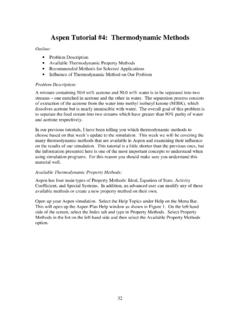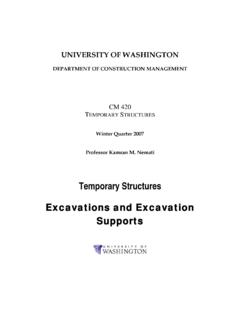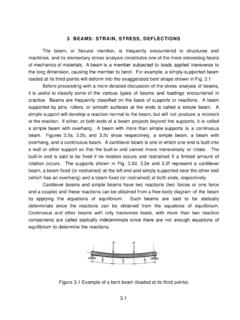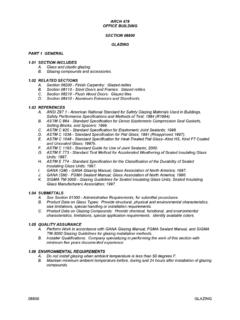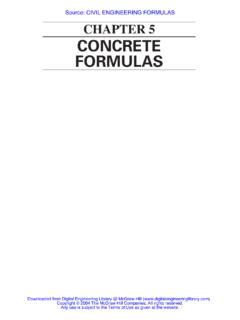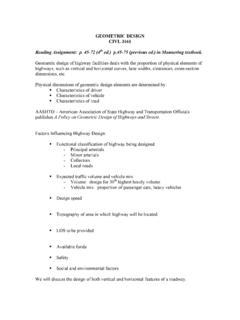Transcription of INTRODUCTION TO INDUSTRIAL ENGINEEING
1 INTRODUCTION TO INDUSTRIAL ENGINEEINGI ndustrial EngineeringDefinitionIndustrial Engineers plan, design, implement and manage integrated production and service delivery systems that production and service delivery systems that assure performance, reliability, maintainability, schedule adherence and cost controlDevelopment of I. Turner, Mize and Case, INTRODUCTION to INDUSTRIAL and Systems engineering I. E. Historyfrom Turner, Mize and Case, INTRODUCTION to INDUSTRIAL and Systems engineering engineering Jobsfrom 2003 BLS% of Eng. Jobs % Growth (2012) 3-9% civil and Environmental 3-9% civil and Environmental 3-9% 3-9% 10-20% All Others< Prospects INDUSTRIAL engineersare expected to have employment growth of 14 percent over the projections decade, faster than the averagefor all occupations.
2 As firms look for new ways to reduce costs and raise productivity, they increasingly will turn to INDUSTRIAL engineers to develop more efficient processes and reduce costs, delays, and waste. develop more efficient processes and reduce costs, delays, and waste. This focus should lead to job growth for these engineers, even in some manufacturing industries with declining employment overall. Because their work is similar to that done in management occupations, many INDUSTRIAL engineers leave the occupation to become managers. Numerous openings will be created by the need to replace INDUSTRIAL engineers who transfer to other occupations or leave the labor engineering Employment 2008 civil engineers278,400 Mechanical engineers238,700 INDUSTRIAL engineers214,800 Electrical engineers157,800 Electronics engineers, except computer143,700 Computer hardware engineers74,700 Aerospace engineers71,600 Aerospace engineers71,600 Environmental engineers54,300 Chemical engineers31,700 Health and safety engineers, except mining safety engineers and inspectors25.
3 700 Materials engineers24,400 Petroleum engineers21,900 Nuclear engineers16,900 Biomedical engineers16,000 Marine engineers and naval architects8,500 Mining and geological engineers, including mining safety engineers7,100 Agricultural engineers2,700 Engineers, all other183,200 distribution by engineering specialty, May 2008 SpecialtyLowest 10%Lowest 25%MedianHighest 25%Highest 10%Aerospace engineers$58,130$72,390$92,520$114,530$1 34,570 Agricultural engineers43,15055,43068,73086,400108,470 Biomedical engineers47,64059,42077,40098,830121,970 Chemical engineers53,73067,42084,680105,000130,24 0 civil engineers48,14058,96074,60094,470115,630 Computer hardware engineers59,17076,25097,400122,750148,59 0 Electrical engineers52,99064,91082,160102,520125,81 0 Electronics engineers, except computer55,33068,40086,370106,870129,920 Environmental engineers45,31056,98074,02094,280115,430 Health and safety engineers, except mining safety engineers and inspectors43,54056,19072,49090,740106,22 0 INDUSTRIAL engineers47,72059,12073,82091,020107,270 Marine engineers and naval architects43.
4 07057,06074,14094,840118,630 Materials engineers51,42063,83081,820102,040124,47 0 Mechanical engineers47,90059,23074,92094,400114,740 Mining and geological engineers, including mining safety engineers45,02057,97075,96096,030122,750 Nuclear engineers68,30082,54097,080115,170136,88 0 Petroleum engineers57,82080,040108,020148,700>166, 400 Engineers, all other49,27067,36088,570110,310132,070UW INDUSTRIAL Engineers Skills engineering Fundamentals CEE, CSE, EE, ME, MSE Communications oral and written Communications oral and written Mathematical Modeling Statistical Analysis Human Interface TeamworkIndustrial engineering Topics Operations Research Production/Manufacturing Control and ManagementManagement Statistical/Numerical Analysis Human Systems DesignOperations Research Topics Optimization Systems engineering Decision Theory Decision Theory Simulation Markov Chains and Queuing TheoryProduction/Manufacturing Control and Management Processes Work Measurement
5 Plant Layout and Material Handling Inventory Control Inventory Control Scheduling CAD/CAM and CNC Human Factors/Ergonomics engineering Economy Information SystemsStatistical/Numerical Analysis Design of Experiments Statistical Quality Control Reliability Reliability Safety Forecasting Computational GeometryIndustrial Engineers Professional Organizations Institute of INDUSTRIAL Engineers (IIE) Institute for Operations Research and Management Sciences (INFORMS) American Society for Quality Control (ASQC) American Society for Quality Control (ASQC) American Production and Inventory Control Society (APICS) Society of Manufacturing Engineers (SME)
6 Society for Decision Sciences Society of American Value Engineers American Association of Cost EngineersIND E 337 GOAL Introduce a variety of topics relating to how IE s are involved in manufacturing and service industries Teach a series of tools IE s apply in studying and Teach a series of tools IE s apply in studying and improving manufacturing and service processes and companiesIND E 337 Skills to be Practiced Written Technical Communication Technical Reading Comprehension Analysis Mathematical and Organizational Analysis Mathematical and Organizational Observation/Data Collectio



